Assignment Task:
Course learning outcomes:
A. Calculate direct and shear stress in components and demonstrate the relationship between stress and strain
B. Apply the theory of bending
C. Calculate the shear stress and angle of twist in circular shafts subjected to torsion
D. Perform linear and rotational dynamic analysis
E. Apply first and second laws of thermodynamics to product feasibility and calculate rates of heat transfer in buildings and products
F. Apply the Gas Laws and properties of real substances to flow and non-flow processes
Assignment - Solid Mechanics
SCENARIO:
You have recently joined the maintenance department of First Flight Company as a trainee engineer. Your direct manager requested you to complete specific tasks to test your knowledge. Part of your report entails that you provide a sound explanation of the theory and calculate specific parameters in terms of the mechanics of materials.
Problem Task -1: Mechanics of Materials
Mechanics of materials provide us with valuable information regarding the behaviour of solid bodies under the influence of loads.
You are required to define and explain the following concepts that relate to mechanics of materials. Use equations and diagrams to supplement your answer:
a) Hook's Law for Plane Stress and Plane Strain
b) Elastic and Plastic stage in a stress strain curve
c) Thermal Stress and Strain
Problem Task -2: Stress & Strain
Your next Problem Task -is to find the following required values
a) A cable sling that has a clevis at each end is lifting a steel plate weighing 27 KN as shown in the below diagram. The diameter of the pins through the devises is 22 mm. each half of the cable is at an angle of 35 degree to the vertical. Find the average shear stress in each pin.
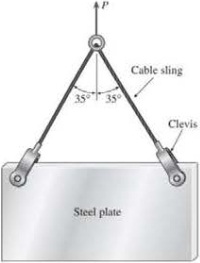
b) Axial Loads are applied at indicated locations on a bronze bar fastened between a steel and an aluminum bar as shown in the below diagram. What should be the highest value of P that will:
a. Limit the total elongation to 3 mm
b. Limit the stress in the steel to 140 MPa
c. Limit the stress in the aluminum to 80 MPa
d. Limit the stress in the bronze to 120 MPa
The assembly is assumed to be suitably braced so buckling will not occur. Consider Est = 200 GPa, Eel= 70 GPa, and Ebr = 83 GPa.

c) Under an applied load P, two wires of different materials and equal length are stretched as shown in the below diagram. Find the ration of the diameter of the copper wire to that of the steel wire. Consider Est = 210 GPa and Ecopper = 120 GPa.
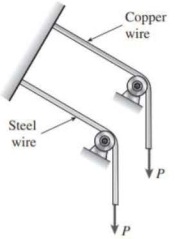
Problem Task -3: Beams & Theory of Bending
Aircraft beam structures can be represented using free-body diagrams in order to carry out certain calculations of the loads exerted on them.
a) Define and Explain Neutral Axis, Section Modulus and Bending Stress. Support you explanation with diagrams and provide the derivation of equations where applicable.
b) The following diagram represents a beam, and shows the various loads that act upon in when it is placed on its ends.
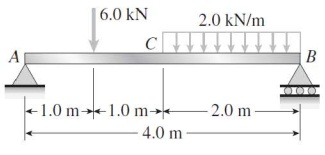
For the given beam:
a. Calculate the support reactions at B and E
b. Construct the shear force diagram
c. Construct the bending moment diagram
d. Given that the section modulus of the spar is 3250 cm3, determine the allowable bending stress, while ignoring the weight of the spar.
c) The below diagram represents the distributed load acting on the wing of a small airplane. Calculate the shear force and bending moment at the inboard end of the wing.
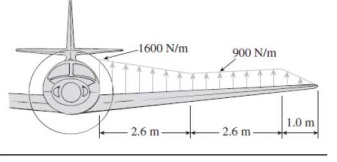
Problem Task -4: Torsion
Drive shafts and drive couplings are all subjected to twisting and torsional loads. An important use of shafts is to transmit power between parallel planes, as in aircraft engines or helicopter rotors.
a) You are required to define and explain the following concepts. Use equations and diagrams to support your answer.
a. Torsion, Torque and the difference between the two terms
b. Angle of Distortion and Angle of Twist
b) The following diagram represents a shaft composed of three segments and fastened to rigid supports
The Shear Modulus For bronze is G = 35 GPa; for aluminium is G = 28 GPa, and for steel is G=83 GPa. Determine the maximum shear stress developed in each segment.
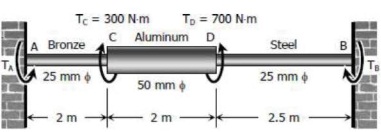
c) The below diagram represents 2 shafts, one is hollow, and one is solid. The hollow is made
of bronze with D = 7 mm and d = 5mm. the solid shaft goes inside the hollow one with diameter equal to the inner diameter of the hollow shaft (d=5mm). Both shafts are rigidly fastened together at their ends.
a. Calculate the torque that can be applied to the composite shaft while limiting the shear stresses in the bronze to 55 MPa and in the steel to 83 MPa
Consider G = 40 GPa for the bronze and G = 83 G Pa for the steel

d) The following diagram represent a steel shaft rotating at 5 Hz with 45 kW output at A, 30 kW removed at B, and 65 kW input at C. Using G = 85 GPa, find:
a. The maximum shear stress
b. The angle of rotation of gear A relative to gear C.

Problem Task -5: Dynamics
The laws of motion define the relationship between forces and how they act on certain bodies that result in uniformly accelerated motion. Since the wing can be regarded as a static structure, we will look into the more dynamic components and systems on the aircraft.
a) Define second Newton's lows of motion with regard to the cruise of an aircraft. In your answer you should explain how this law is applied by the aircraft for its motion. Use diagrams to support your answer.
b) An object is located inside a plane and is moving. The weight of the object is 0.01 kg. The coordinates of the object are given by the below equations:
x(t) = 2t3 - t2 and y(t) = 4t2 + 2t
Find the net force acting on the object at t=2 s.
c) Two boxes are pulled by a force F as shown in below figure. If the friction assumed to be zero and the box X has an acceleration of 4m/s2, calculate the acceleration of the box Y.

d) While stopping at the side of the road, a police car spots a speeding motorist travelling at 160 km/h. An immediate chase start, with the police car accelerating at a constant 2.5 m/s2.
i. Find the time required for the police car to intercept the speeder
ii. Calculate the distance travelled by the police car before the interception
iii. What was the velocity of the police car at the interception?
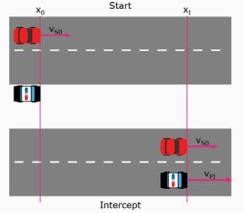
Anyone can avail our Engineering Science Assignment Help service anytime and from anywhere and get assured A++ grades, without putting their hands into the tedious job of assignment writing!!
Tags: Engineering Science Assignment Help, Engineering Science Homework Help, Engineering Science Coursework, Engineering Science Solved Assignments, Solid Mechanics Assignment Help, Solid Mechanics Homework Help, Mechanics of Materials Assignment Help, Mechanics of Materials Homework Help, Stress & Strain Assignment Help, Stress & Strain Homework Help, Beams & Theory of Bending Assignment Help, Beams & Theory of Bending Homework Help, Torsion Assignment Help, Torsion Homework Help, Dynamics Assignment Help, Dynamics Homework Help